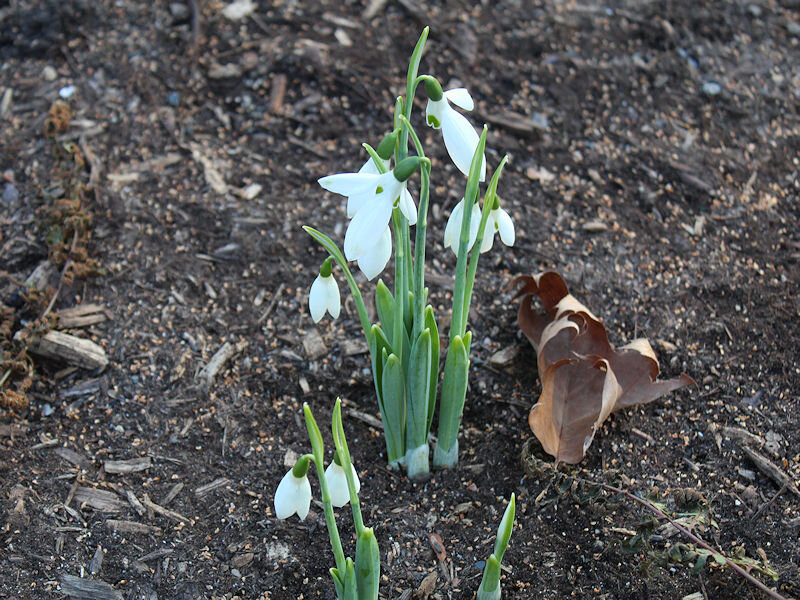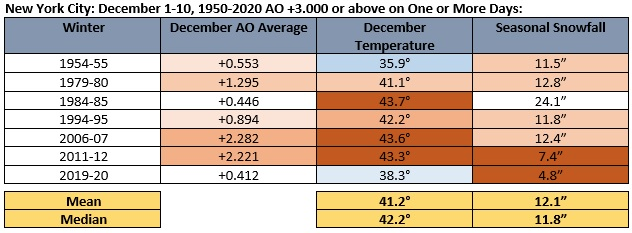-
Posts
23,181 -
Joined
Content Type
Profiles
Blogs
Forums
American Weather
Media Demo
Store
Gallery
Everything posted by donsutherland1
-
Morning thoughts… Today will be partly cloudy and pleasant. High temperatures will likely reach the upper 40s and lower 50s in most of the region. Likely high temperatures around the region include: New York City (Central Park): 48° Newark: 51° Philadelphia: 52° Normals: New York City: 30-Year: 47.4°; 15-Year: 47.8° Newark: 30-Year: 47.9°; 15-Year: 48.5° Philadelphia: 30-Year: 49.0°; 15-Year: 49.7° Tomorrow will be very mild, but cooler air will return afterward. A system could bring some snow to the region on Wednesday.
-
It’s a low probability situation, but some snow would still be better than none. I am looking forward to tonight’s guidance.
-
It’s all good. I hope he gets the snow he craves. Even if not, he can be happy with the Mets’ big free agent signing.
-
I am hopeful that this won’t be a relatively snowless winter, but the recent push by the AO to strongly positive levels as typically preceded winters with below to much below normal snowfall.
-
The 18z GFS scenario isn’t very likely. The individual EPS members suggest only a very low probability of such an outcome. If the AO+, NAO+, PNA- forecast is accurate, the largest storm during the December 1-20 period occurred during December 19-20, 2008 with 4.5” in NYC. More than a foot fell in parts of southern New England. It is too soon to write off a snowfall, but a lot more support from the other guidance will be needed to accept something along the lines of the 18z GFS. Such an outcome might not even show up on the 0z cycle.
- 289 replies
-
- 10
-

-

-

-
Much warmer will begin to arrive tomorrow. As a result, clouds will be plentiful during the latter part of the day and at night. The temperature will then hold nearly steady at night. Then, on Monday, temperatures could soar into the 60s in much of the region. Afterward, a system could bring rain and snow to parts of the region on Wednesday. A small accumulation is possible even in New York City and Newark. No Arctic blasts appear likely for the foreseeable future. First measurable snowfall statistics for select cities: Allentown: Normal: December 6; 2020-21: December 9 Bridgeport: Normal: December 3; 2020-21: December 16 Islip: Normal: December 10; 2020-21: December 16 New York City: Normal: December 13; 2020-21: December 16 Newark: Normal: December 9; 2020-21: December 9; 2021-22: November 28 Philadelphia: Normal: December 19; 2020-21: December 16 Out West, Denver has yet to see its first measurable snowfall through December 3. The previous record latest first measurable snowfall occurred on November 21, 1934. The progression of Denver's latest first measurable snowfall of the season is as follows: November 11, 1882 November 16, 1894 November 19, 1931 November 21, 1934 Atlantic blocking (AO and NAO) has now broken down even earlier than had been modeled just a few days ago. In response, the first half of December will likely be warmer than normal. Afterward, developments related to the EPO and AO could determine the outcome for much of the remainder of the month. Following very wet July-September periods, winter (December-February) precipitation has typically been near or below normal. The most recent exception was winter 2018-19. The ENSO Region 1+2 anomaly was -1.0°C and the Region 3.4 anomaly was -0.7°C for the week centered around November 24. For the past six weeks, the ENSO Region 1+2 anomaly has averaged -0.80°C and the ENSO Region 3.4 anomaly has averaged -0.90°C. La Niña conditions will likely persist into at least late winter. The SOI was +11.73 today. The preliminary Arctic Oscillation (AO) figure was +2.262 today On December 2 the MJO was in Phase 6 at an amplitude of 2.066 (RMM). The December 1-adjusted amplitude was 1.749 (RMM).
-
Thanks, Rclab. Yes, the first photo is forsythia. It is breaking out in bloom in many parts of the region. I'm not sure what type of rose I photographed, as there was no sign by the bush. Usually, the Botanical Garden closes its rose garden before the start of December, but not this year. Thanks for sharing your memory. Very best wishes, Don
-
Under partly sunny skies, the temperature rose into the upper 40s in the New York City area. At the New York Botanical Garden, numerous plants remain in blossom.
-
Morning thoughts… Today will be variably cloudy and cool. High temperatures will likely reach the upper 40s and lower 50s in most of the region. Likely high temperatures around the region include: New York City (Central Park): 47° Newark: 50° Philadelphia: 53° Normals: New York City: 30-Year: 47.7°; 15-Year: 48.1° Newark: 30-Year: 48.2°; 15-Year: 48.8° Philadelphia: 30-Year: 49.3°; 15-Year: 50.0° Milder air will begin to return tomorrow.
-
Modestly cooler air has returned, but the cool spell will be short-lived. Much warmer air could arrive late in the weekend ahead of the next cold front. Afterward, a system could bring rain and snow to parts of the region on Wednesday. No Arctic blasts appear likely for the foreseeable future even as meteorological winter has now gotten underway. First measurable snowfall statistics for select cities: Allentown: Normal: December 6; 2020-21: December 9 Bridgeport: Normal: December 3; 2020-21: December 16 Islip: Normal: December 10; 2020-21: December 16 New York City: Normal: December 13; 2020-21: December 16 Newark: Normal: December 9; 2020-21: December 9; 2021-22: November 28 Philadelphia: Normal: December 19; 2020-21: December 16 Out West, Denver has yet to see its first measurable snowfall through December 2. The previous record latest first measurable snowfall occurred on November 21, 1934. The progression of Denver's latest first measurable snowfall of the season is as follows: November 11, 1882 November 16, 1894 November 19, 1931 November 21, 1934 Atlantic blocking (AO and NAO) has now broken down even earlier than had been modeled just a few days ago. In response, the first half of December will likely be warmer than normal. Afterward, developments related to the EPO and AO could determine the outcome for much of the remainder of the month. Following very wet July-September periods, winter (December-February) precipitation has typically been near or below normal. The most recent exception was winter 2018-19. The ENSO Region 1+2 anomaly was -1.0°C and the Region 3.4 anomaly was -0.7°C for the week centered around November 24. For the past six weeks, the ENSO Region 1+2 anomaly has averaged -0.80°C and the ENSO Region 3.4 anomaly has averaged -0.90°C. La Niña conditions will likely persist into at least late winter. The SOI was +12.30 today. The preliminary Arctic Oscillation (AO) figure was +3.144 today. This is the highest AO figure since March 26, 2021 when the AO stood at +3.216. On December 1 the MJO was in Phase 5 at an amplitude of 1.737 (RMM). The November 30-adjusted amplitude was 1.465 (RMM).
-
The preliminary December 3 value of the Arctic Oscillation (AO) was +3.144. The development of such high values during the December 1-10 period has often indicated that December will be warmer to much warmer than normal and that seasonal snowfall in the New York City area will be below to much below normal. There have been 7 such prior cases during the 1950-2020 period. Those cases are below.
-
Morning thoughts… Today will be partly cloudy, breezy, and cooler. High temperatures will likely reach the middle and upper 40s in most of the region. Likely high temperatures around the region include: New York City (Central Park): 46° Newark: 49° Philadelphia: 51° Normals: New York City: 30-Year: 48.0°; 15-Year: 48.4° Newark: 30-Year: 48.6°; 15-Year: 49.1° Philadelphia: 30-Year: 49.6°; 15-Year: 50.3° Milder air will return during the weekend.
-
Final Records for December 2, 2021: Billings: 69° (old record: 63°, 1939 and 1956) Casper: 66° (old record: 59°, 1939) ***new December record*** Cheyenne: 70° (old record: 64°, 1885) ***new December record*** Dodge City, KS: 80° (old record: 74°, 1995) Grand Island, NE: 73° (old record: 70°, 2012) Great Falls: 60° (tied record set in 1941 and tied in 1959) Helena: 64° (old record: 58°, 1941) Kalispell, MT: 59° (old record: 57°, 1941) Lincoln, NE: 71° (old record: 68°, 2012) Missoula: 61° (old record: 58°, 1941) North Platte, NE: 71° (old record: 69°, 1885 and 2012) Omaha: 68° (old record: 67°, 1973) Phoenix: 84° (tied record set in 2017) Rapid City: 75° (old record: 69°, 1960) ***tied December record*** Sheridan, WY: 77° (old record: 70°, 1941) ***tied December record*** Sidney, NE: 78° (old record: 67°, 2017) ***2nd consecutive new December record*** Wichita: 74° (old record: 69°, 2012)
-
Despite mainly cloudy skies, the temperature surged into the upper 50s in much of the region. Modestly colder air will return tomorrow. No Arctic blasts appear likely for the foreseeable future even as meteorological winter has now gotten underway. First measurable snowfall statistics for select cities: Allentown: Normal: December 6; 2020-21: December 9 Bridgeport: Normal: December 3; 2020-21: December 16 Islip: Normal: December 10; 2020-21: December 16 New York City: Normal: December 13; 2020-21: December 16 Newark: Normal: December 9; 2020-21: December 9; 2021-22: November 28 Philadelphia: Normal: December 19; 2020-21: December 16 Out West, Denver has yet to see its first measurable snowfall through December 1. The previous record latest first measurable snowfall occurred on November 21, 1934. The progression of Denver's latest first measurable snowfall of the season is as follows: November 11, 1882 November 16, 1894 November 19, 1931 November 21, 1934 Exceptional warmth again prevailed in parts of the West today. Preliminary record values included: Billings: 69° (old record: 63°, 1939 and 1956) Casper: 65° (old record: 59°, 1939) ***tied December record*** Cheyenne: 70° (old record: 64°, 1885) ***new December record*** Dodge City, KS: 79° (old record: 74°, 1995) Grand Island, NE: 72° (old record: 70°, 2012) Great Falls: 60° (tied record set in 1941 and tied in 1959) Helena: 64° (old record: 58°, 1941) Kalispell, MT: 59° (old record: 57°, 1941) Lincoln, NE: 70° (old record: 68°, 2012) Missoula: 61° (old record: 58°, 1941) North Platte, NE: 69° (tied record set in 1885 and tied in 2012) Omaha: 67° (tied record set in 1973) Rapid City: 73° (old record: 69°, 1960) Sheridan, WY: 76° (old record: 70°, 1941) Sidney, NE: 76° (old record: 67°, 2017) ***2nd consecutive new December record*** Wichita: 74° (old record: 69°, 2012) Atlantic blocking (AO and NAO) has now broken down even earlier than had been modeled just a few days ago. In response, the first half of December will likely be warmer than normal. Afterward, developments related to the EPO and AO could determine the outcome for much of the remainder of the month. Following very wet July-September periods, winter (December-February) precipitation has typically been near or below normal. The most recent exception was winter 2018-19. The ENSO Region 1+2 anomaly was -1.0°C and the Region 3.4 anomaly was -0.7°C for the week centered around November 24. For the past six weeks, the ENSO Region 1+2 anomaly has averaged -0.80°C and the ENSO Region 3.4 anomaly has averaged -0.90°C. La Niña conditions will likely persist into at least late winter. The SOI was +10.74 today. The preliminary Arctic Oscillation (AO) figure was +2.452 today. On November 30 the MJO was in Phase 5 at an amplitude of 1.155 (RMM). The November 29-adjusted amplitude was 1.018 (RMM).
-
That’s a fair point.
-
I saw some of those social media posts. Despite the social media chatter, December 2021 was not destined to become a “repeat” of December 1995 (or winter 2021-22 to become a kind of replay of 1995-96). Then, the PDO was neutral/weakly positive, strong/severe Atlantic blocking + a persistent PNA+ developed after the first week of December. This time around, things are starkly different. The PDO is strongly negative, Atlantic blocking dissipated with none shown for at least the next two weeks, and a PNA- regime is set to develop. Posted maps on social media showing similarities lack context (384-hour maps showing extreme Arctic outbreaks, etc., lack skill). One needs to dig into the details that are never provided on social media. The big differences between 1995 and 2021 suggest that any similarities at 500 mb or surface anomalies in the near-term would likely be brief.
-
Translation: There are no words that can fully describe how ugly that is.
-
Morning thoughts… Today will be mostly cloudy and unseasonably warm. High temperatures will likely reach the middle and upper 50s in most of the region. Likely high temperatures around the region include: New York City (Central Park): 56° Newark: 59° Philadelphia: 61° Normals: New York City: 30-Year: 48.4°; 15-Year: 48.7° Newark: 30-Year: 48.9°; 15-Year: 49.4° Philadelphia: 30-Year: 50.0°; 15-Year: 50.6° Cooler air will return tomorrow.
-
Final high temperatures: Bismarck: 66° (old record: 62°, 1969) ***tied December record***Denver: 73° (tied daily record set in 1973)Glasgow, MT: 69° (old record: 62°, 1925) ***tied December record***Great Falls: 69° (old record: 60°, 1907 and 1969) ***tied December record***Helena: 70° (old record: 60°, 2008) ***new December record***Kalispell, MT: 62° (old record: 54°, 1925) ***new December record***Missoula, MT: 67° (old record: 55°, 1972) ***new December record***Omak, WA: 74° (old record: 57°, 1949) ***new December record***Phoenix: 85° (old record: 83°, 1949)Rapid City: 74° (old record: 71°, 1973)Sheridan, WY: 76° (old record: 71°, 1995)Tucson: 85° (old record: 84°, 1926) ***tied December record***
-
Overnight, it will be mostly cloudy with some showers. Tomorrow will be unseasonably mild with temperatures rising well into the 50s in much of the region. Colder air will return on Friday. No Arctic blasts appear likely for the foreseeable future even as meteorological winter has now gotten underway. First measurable snowfall statistics for select cities: Allentown: Normal: December 6; 2020-21: December 9 Bridgeport: Normal: December 3; 2020-21: December 16 Islip: Normal: December 10; 2020-21: December 16 New York City: Normal: December 13; 2020-21: December 16 Newark: Normal: December 9; 2020-21: December 9; 2021-22: November 28 Philadelphia: Normal: December 19; 2020-21: December 16 Out West, Denver has yet to see its first measurable snowfall through November 30. The previous record latest first measurable snowfall occurred on November 21, 1934. Incredible warmth prevailed in parts of the West today. Preliminary record values included: Bismarck: 66° (old record: 62°, 1969) ***tied December record*** Denver: 73° (tied daily record set in 1973) Glasgow, MT: 66° (old record: 62°, 1925) Great Falls: 69° (old record: 60°, 1907 and 1969) ***tied December record*** Helena: 69° (old record: 60°, 2008) ***new December record*** Kalispell, MT: 61° (old record: 54°, 1925) ***new December record*** Missoula, MT: 66° (old record: 55°, 1972) ***new December record*** Omak, WA: 72° (old record: 57°, 1949) ***new December record*** Phoenix: 85° (old record: 83°, 1949) Rapid City: 72° (old record: 71°, 1973) Sheridan, WY: 76° (old record: 71°, 1995) Tucson: 85° (old record: 84°, 1926) ***tied December record*** Atlantic blocking (AO and NAO) is continuing to break down. As a result, temperatures will likely turn milder for at least a time. Although the first 10 days of December could average somewhat cooler than normal overall from a lag in the pattern response to the breakdown in Atlantic blocking, the first half of the month overall will likely average near normal or somewhat warmer than normal. Afterward, developments related to the EPO and AO could determine the outcome for much of the remainder of the month. For now, there remains uncertainty about the evolution of the teleconnections. However, it appears more likely than not (60% implied probability) that December will see a warm anomaly in the Northeast. Following very wet July-September periods, winter (December-February) precipitation has typically been near or below normal. The most recent exception was winter 2018-19. The ENSO Region 1+2 anomaly was -1.0°C and the Region 3.4 anomaly was -0.7°C for the week centered around November 24. For the past six weeks, the ENSO Region 1+2 anomaly has averaged -0.80°C and the ENSO Region 3.4 anomaly has averaged -0.90°C. La Niña conditions will likely persist into at least late winter. The SOI was +10.74 today. The preliminary Arctic Oscillation (AO) figure was +1.646 today. On November 29 the MJO was in Phase 5 at an amplitude of 1.155 (RMM). The November 28-adjusted amplitude was 1.018 (RMM).
-
New York City's mean monthly temperature fell from 62.0° to 46.2°, a change of 15.8°. That change was 1.315 sigma above the historic (1869-2020) October-November change. Such an outcome has often precluded a severely cold December. The historic November-December change is 10.2°. The 23 cases with a 1 sigma or greater change above the October-November average saw an average 7.8° change in temperature during the November-December timeframe. In 65% of the cases, the change was smaller than the normal change. In 35% of cases, the change was 1 sigma or more below the historic November-December change. All of those 1 sigma cases would imply a December mean temperature of 40° or above. The change was 0.5 sigma or more above the historic November-December change in just 13% of the cases. The most recent year that saw a 1 sigma or more change from the historic October-November change was 2019. In December, the temperature fell 5.6° from November to 38.3°. In terms of seasonal snowfall, a larger than normal decline in the November-December period for the 1 sigma October-November cases was snowier than the more typical smaller decline. Smaller November-December Temperature Change: Mean Seasonal Snowfall: 23.5" Median Seasonal Snowfall: 19.7" Distribution: 40" or more: 13% 30" or more: 27% 20" or more: 47% < 20": 53% < 10": 7% Least: 4.8", 2019-20 Most: 57.4", 2013-14 n=15 Larger November-December Temperature Change: Mean Seasonal Snowfall: 39.0" Median Seasonal Snowfall: 32.9" Distribution: 40" or more: 38% 30" or more: 63% 20" or more: 75% < 20": 25% < 10": 13% Least: 11.5", 1954-55 Most: 75.6", 1995-96 n=8
-
Morning thoughts... Today will be variably cloudy, breezy, and a bit milder. Temperatures will likely reach the middle and upper 40s across much of the region. Likely high temperatures include: New York City (Central Park): 46° Newark: 50° Philadelphia: 50° Tomorrow will be noticeably milder as a cold front pushes toward the region. Normals: New York City: 30-Year: 48.7°; 15-Year: 49.0° Newark: 30-Year: 49.3°; 15-Year: 49.8° Philadelphia: 30-Year: 50.3°; 15-Year: 50.9° 30-Day Verification: New York City (Central Park): Average daily forecast: 52.1° Average temperature: 52.6° Average error: 1.1° Newark: Average daily forecast: 56.0° Average temperature: 55.8° Average error: 1.2° Philadelphia: Average daily forecast: 55.0° Average temperature: 55.6° Average error: 1.3°







